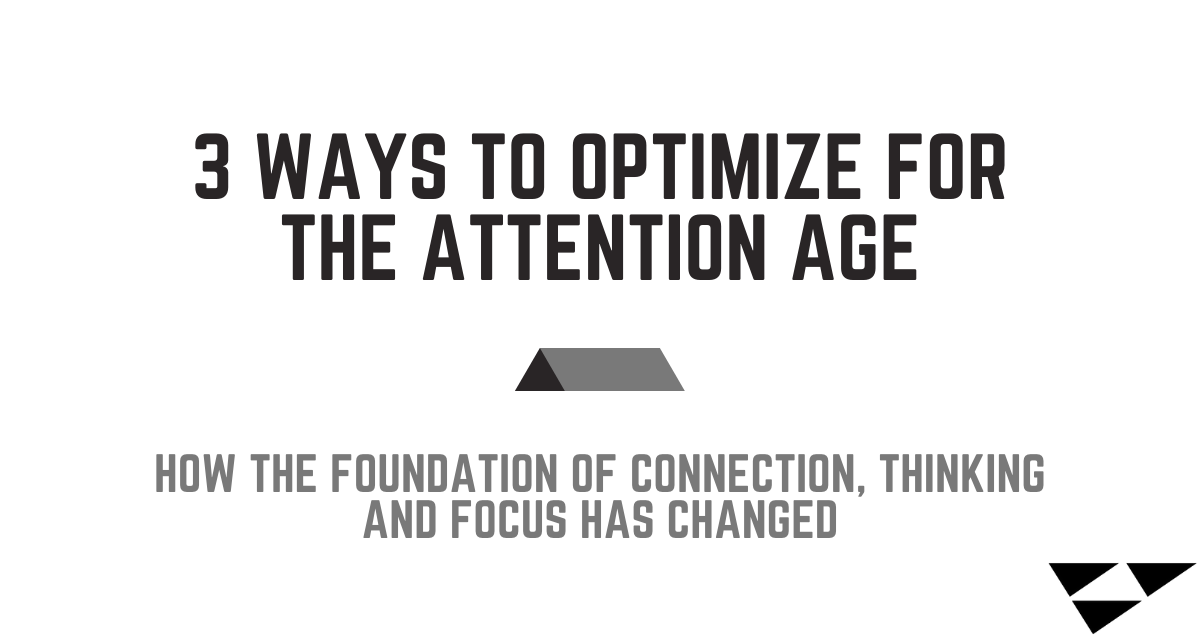How the foundation of connection, thinking and focus has changed.
In the Information Age, value was in the creation, transmission, storage, and sale of information.
In the Attention Age, value is in the application of, focus of, quality of, and sale of human attention.
The changing of an age brings with it new and changing inter-human dynamics. Understanding three key differences between the Information Age and the Attention Age can give you an edge throughout the transition.
- Human Communication
- Workplace need for higher order thinking
- Attention is fragmented
Let’s take a closer look at each of these.
Human Communication
The Information Age brought the creation of myriad platforms for communication. Smartphones, text chat apps, social apps, social messengers, workplace communication platforms, email—the list could go on. The sheer number of options has caused a small phenomenon; communication between humans has shifted away from face-to-face, and has become chopped up into smaller and smaller bites of consciousness.
Prior to the Information Age, the primary methods for communication were long-form: social face-to-face conversations, phone conversations, and letters.
Today, the average length of a text message is seven words.
We communicate in snippets.
This causes the quality of human communication, both personal and professional, to decrease even if quantity has increased.
How can you improve your human communication?
Define the purpose – When communicating, face-to-face or via technical means, take a minute to define the purpose. What is the outcome you want? Be upfront about the purpose and give a call to action. This way you will communicate with intent.
Face-to-Face communication trumps all other forms – To the maximum extent, refrain from indulging in any other form of communication while you are actively conversing with a person face-to-face. Not only is it disrespectful to check your phone during a conversation, it undermines both channels of communication.
Higher Order Thinking
Every few years, the World Economic Forum produces a list of its 5 year predictions of the top job skills required by the workplace. In their 2025 list, 7 of the 10 job skills related to problem solving and self-management. Their list for 2015 included only 5 of the 10 skills related to personal cognitive abilities. [1]
The Information Age produced computers that can do amazing things. As a result, companies and organizations no longer need people whose skills are replicated by computers. Organizations need people with skills that cannot be accomplished with a machine. They need people who can leverage a computer to solve a problem.
As computers continue to advance, the skills organizations hire for are higher order thinking skills: complex problem solving, creativity, analytical thinking, and ideation. These skills are innately human—computers cannot be creative.
How can you gain an edge?
Learn – Never stop learning. Your primary and secondary education is just the springboard.
Cut out activities that promote lower-order thinking – While not all bad, excessive use of social media, TV, and gaming keeps your mind in a reactionary state. Instead of taking an active role, your thinking is driven by the creators of the games and shows, or the content / algorithms of social media.
Attention is Fragmented
The sheer amount of information, decisions, advertisements, visual and auditory stimulants humans process every day is unprecedented, and ever-increasing. Everyday people see thousands of ads. In five minutes on Facebook you see well over 100 different videos, images and posts. The practice of ‘dual screening’, the art of watching TV while scrolling on a phone or laptop, is increasingly common.
This chronic behavior of taking in information and visual stimulants at breakneck pace causes attention spans to decrease, and has trained our brains to require the constant flow of information.
Since we are constantly switching between tasks or from post-to-post, deep work does not happen.
How can you rise above the crowd?
Observe – I challenge you to take a few minutes to think about how you use your time and attention throughout a typical day. Are you distracted while working on a project? How long do you stand in a line before whipping out the phone? Look up your screen time stats on your phone; what do the numbers say?
Practice – Defragmenting your attention will make you more productive, more likable, and will boost your standard. Close the tabs, kill the notifications, place the phone in another room, turn off the TV. Defragmenting your attention won’t happen overnight, but persistence in building good habits will pay dividends for a lifetime.
Conclusion
I challenge you to take action. Choose one way you can improve in each of the three areas. How can you better communicate with those you live and work with? How can you make learning a lifestyle? What is one specific way you can defragment your attention today?
Now is the time to optimize your habits and interactions for the Attention Age. I want to help you become the leader your team needs.
If you want to focus your attention on what matters, when it matters, send me an email or schedule a phone call with me to see how we can make that happen.




